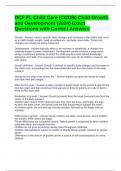DCF FL Child Care (CGDR) Child Growth
and Development (2024) Exam
Questions with Correct Answers
Growth - Answer-refers to specific body changes and increases in the child's size, such
as a child's height, weight, head circumference, and body mass index. These size
changes can usually be easily measured.
Development - Answer-typically refers to an increase in complexity, a change from
relatively simple to more complicated. Development usually involves a progression
along a continuous pathway on which the child acquires more refined knowledge,
behaviors, and skills. The sequence is basically the same for all children, however, the
rate varies.
Growth definition - Answer-Growth is defined as specific body changes and increases in
the child's size, proceeding from the head downward and from the center of the body
outward.
During the first year of an infant's life, - Answer-babies can grow ten inches in length
and triple their birth weight.
After the first year, - Answer-a baby's growth in length slows to five inches a year for the
next two years and then continues from age two or three to puberty at a rate of two to
three inches each year.
Similarities in growth: - Answer-Growth proceeds from the head downward and from the
center of the body outward.
Children gain control of the head and neck first, then the arms, and finally, the legs.
At birth, the brain, heart, and spinal cord are fully functioning to support the infant.
As children grow, the arm and leg muscles develop, followed by the finger and toe
muscles.
Differences in growth: - Answer-Some children are taller, some shorter. Some children
are smaller, while others are larger.
These differences are completely typical. Typical growth is supported by good nutrition,
adequate sleep, and regular exercise.
Children do not grow at perfectly steady rates throughout childhood.
Children will experience weeks or months of slightly slower growth, followed by growth
spurts.
Differences in the amount of growth can be a source of self-consciousness for some
children.
,Because each child is different and special, it is important to help them understand this
concept in order to develop a sense of self-acceptance. - Answer-It is important to help
the children in your care understand that differences in growth patterns are typical.
Development definition - Answer-Development refers to an increase in complexity; a
change from relatively simple to more complicated.
Progress - Answer-Development usually involves a progression along a continuous
sequential pathway on which the child acquires more refined knowledge, behaviors, and
skills.
Rate varies - Answer-The developmental sequence is basically the same for all
children; however, the rate of development varies from child to child
Principles of Child Development - Answer-There are five principles related to the
progression of general development that children will typically experience.
1 - Developmental Sequence is Similar for All - Answer-Children develop in relatively
the same ways.
There is a typical sequence of development that occurs as a child grows.
While the sequence is similar, and the behaviors or skills emerge in the same order,
children can take more or less time with each behavior or skill.
They can move forward, regress for a short time, then move forward again.
Some children may skip a behavior or skill as they move forward.
2 - Development Proceeds from General to Specific - Answer-Development progresses
from a beginning point moving in a forward direction.
Just as growth of an infant proceeds from the top down and from the center of the body
to the limbs, development of behaviors and skills moves from general to specific.
As children mature, their bodily changes occur in a sequential order and give children
new abilities.
As the brain and nervous system develop, a child's thinking (cognitive) skills and motor
skills improve.
In the Physical Development Domain, an infant's large muscles develop first and result
in the ability to wave the arms and kick the legs.
Development continues in the smaller muscles in the fingers and toes, and results in the
ability of the fingers to grasp objects and the toes to help with balance when standing
and walking.
3 - Development is Continuous - Answer-In children who develop typically, behaviors
and skills they have already acquired become the basis for new behaviors and skills.
There is continuity from one phase of development to the next.
Children continue to add new behaviors and skills as they perfect their abilities to walk,
to write or draw, and to speak. For example, speech development proceeds from
gurgles and coos to chattering, then to words, then phrases, and finally, sentences.
Sentences become paragraphs and stories, both oral and written.
, In order for children to write or draw, they must have developed the control of their
hands and fingers to hold a crayon and pencil. Holding a pencil develops into writing
and drawing.
The continuation of development can easily be seen in children as they mature from
age two to age twelve.
4 - Development Proceeds at Different Rates - Answer-Each child is different and the
rates at which individual children develop are different.
Although the sequences for development are usually the same for all children, the rates
at which individual children reach each stage will be different.
Some children will walk at ten months of age, while others walk at eighteen months of
age.
Development is never uniform, but it is constant.
5 - All Areas of Development are Interrelated - Answer-Development in children is
interrelated.
There are several examples in Principles 1 through 4 that show how the body has to
grow and develop before new behaviors and skills can occur.
These examples also demonstrate the first two of five areas of development, called
domains.
Each area of development influences development in other areas.
Each of these developmental domains can be defined by one or more characteristics.
The five domains of development are.. - Answer--Physical Development (PD),
-Cognitive Development and General Knowledge (CDGK),
-Language and Communication (LC),
-Social and Emotional Development. (SED), and
-Approaches to Learning. (ATL)
The characteristics of the Physical Development Domain (PD) - Answer-involve
increased physical growth and abilities.
There are many characteristics of the Cognitive Development and General Knowledge
Domain, and the Approaches to Learning Domain, which include - Answer-thinking,
planning, creating, exploring, and questioning.
The Language and Communication (LC) Domain includes - Answer-a child's abilities to
see, hear, speak, read, and write.
The Social and Emotional Development (SED) Domain is defined by - Answer-forming
relationships and attachments.
Developmental Sequence is Similar for All - Answer-In the Infant Care Center this fall,
you noticed four-month-old Sara roll over; a few weeks later, she began scooting. By
December, six-month-old Raul had rolled over and scooted. Last week, you noted that





